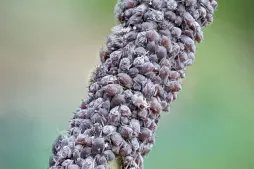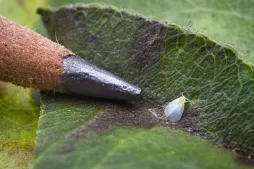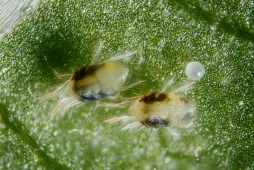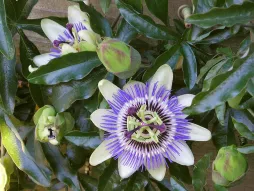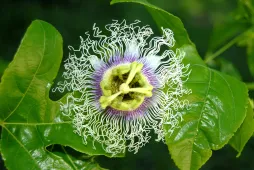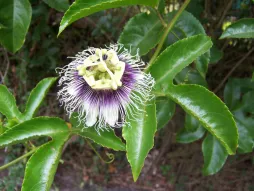Passiflora incarnata, passion flower
Don't count on Passiflora incarnata to help you rekindle the flame or ignite passions. Passion flower is used in naturopathy for its soothing and sedative virtues. Or plant some in your garden! Its colorful, fragrant flowers will awaken your senses.
How to recognize Passion flower, Passiflora incarnata?
Passiflora incarnata is a climbing shrub. It grows to a height of four meters and spreads almost three meters.
The herbaceous stems are voluble. The lianas use tendrils at the base of the leaves to cling to their support.
Like blue passionflower (Passiflora caerulea), passionflower has palmate leaves. However, they have only three sections. The dark-green lobes are elliptical to lanceolate. The foliage, like the stems, disappears when temperatures fall below freezing.
In summer, passionflower blooms fragrantly. Flowers appear in the leaf axils, borne on a pubescent stalk. They consist of three green bracts, five white sepals and five pink or purple petals. Their color contrasts with that of the crown of blue or purple filaments. In the center of the flower, the five stamens and three styles form an original pattern.
Once pollinated, Passiflora incarnata produces a greenish-yellow berry, five centimetres long. The fruit is edible, but not very tasty.
The rest of the plant (stems and leaves) is slightly toxic. If ingested, it can cause digestive problems and even disorientation. Keep the plant away from your four-legged friends!
Our maintenance tips
Would you like your Passion flower to bear fruit? You may need to grow several specimens. Some self-sterile varieties need to be planted alongside others passiflora officinalis for pollination to take place.
Watering
Your Passion flower likes its soil to be moist. But it hates excess water. Water when the surface of the substrate is dry (about a centimetre).
Use room-temperature, non-calcareous water, such as rainwater.
Drain any water that collects in the saucer or planter. It may rot the roots.
Repotting
Passiflora officinalis are fast-growing. Choose a pot with holes at least 40 centimetres deep to give the plant room to develop its root system. You can line the bottom with a layer of clay balls or gravel to improve drainage.
Your plant needs a rich, draining substrate. You can mix equal parts topsoil and potting soil and add a handful of compost and sand. If you don't have any, a mixture for Mediterranean plants is also suitable.
Pour substrate into the hole. If you have provided a stake, install it in your pot now. Plant your Passion flower. The collar and root ball should be a few centimetres below the rim of the pot to leave a watering trough. Add potting soil up to the root ball. Tamp and water.
Your plant will cling to its support itself thanks to its tendrils. But you'll need to give it a little help when planting. Arrange the vines in a zigzag pattern along your wall, pergola or fence.
Fertilization
Place compost at the foot of your Passion flower.
You can stimulate the growth of your plant during its growth phase, in spring and summer, with fertilizer.
Fertilize your Passion flower every month. Use a flowering plant fertilizer to stimulate flowering.
Harvest
Depending on the variety, fruit is harvested between early and late summer.
Fruit falls by itself when ripe.
Prune
Remove dry, yellowed leaves.
Using clean, sharp pruning shears, cut back dead branches.
You can also shorten branches to maintain a compact habit.
Plantation
Once the last spring frosts have passed, you can plant.
Soak your Passiflora incarnata to rehydrate the root ball.
The plant has extensive roots. Dig a hole of at least 40 centimetres in all directions to accommodate it. If your soil is heavy and tends to retain water, place two to three centimetres of clay balls or gravel at the bottom to improve drainage.
Prepare a mixture containing equal parts garden soil and potting soil. Add a handful of compost. Pour on a layer of substrate and plant your plant. The rootball should reach ground level.
Fill in the hole, compact and water. You can mulch with a mineral or organic material to keep the plant cool.
Passiflora officinalis plants have tendrils at the base of their leaves, enabling them to hang on. Planted next to a low wall, trellis or pergola, your plant will climb naturally. But you can encourage it by guiding its vines along the support. It's best to run them in a zigzag or horizontal pattern to stimulate growth.
Cutting
Cutting is carried out during the strong growth phase, generally in spring and early summer.
Choose a stem with a soft tip and no flowers. Using a clean, sharp pair of pruning shears, remove a section of about fifteen centimetres with at least three nodes.
Remove the leaves at the base of the plant, keeping only the pair at the top. You can tie up the leaves or halve their size to limit evapotranspiration.
Pour a mixture of potting soil and sand into a pot whose hole has been plugged with a pebble. Push half the stem of your cutting into the center without watering.
Place the pot in a mini greenhouse; if you don't have one, you can cover the plant with a translucent bag or a cut bottle. Place your graft in a bright spot, without direct sunlight.
Every day, aerate for a few minutes to drain off condensation and mist.
Every day, aerate for a few minutes to drain off condensation and mist.
Diseases / Threats
Information
| Family | Passifloraceae - Passifloraceae |
| Type | Passionflower - Passiflora |
| Species | Passion flower - Passiflora incarnata |
| Lifecycle | Perennial |
| Foliage | Semi-evergreen |
| Exposures | |
| Substrats | |
| Planting methods |
Open ground In pots In tubs |
| Categories | |
| Tags |
Beginner Flowery Toxic |
| Origin |
North America |
| Hardiness (USDA) | 8a |
| Leaf color |
|
| Flower colors |
|
| Fruit colors |
|
Discover plants from the same family













